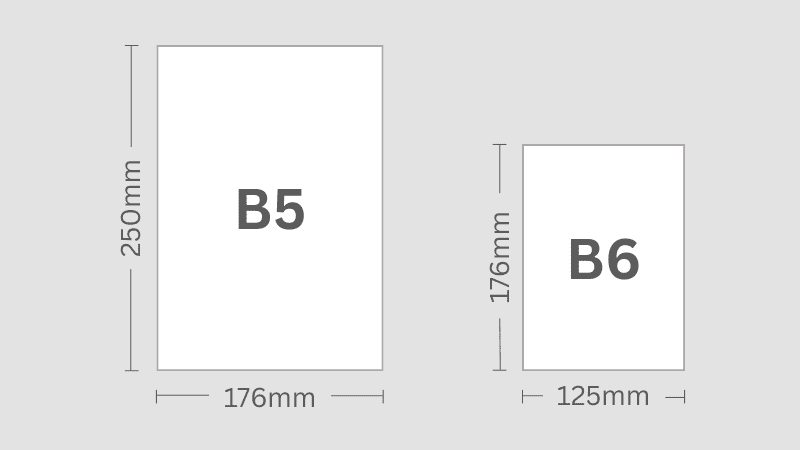Last Updated on June 17, 2025 by Packoi Team
Choosing a notebook size may seem simple until you realize the number of options that exist in the market. Between A4, B5, Letter, and other regional formats, it’s easy to get confused. The size you choose can affect usability, portability, and even productivity.
To help you make an informed decision, we’ve created this comprehensive guide on selecting the right notebook size, where we’ll explain international sizing standards and offer practical tips for choosing the best format based on your use case. Let’s get started!
Understanding the Basics of Notebook Sizing
You’ve likely heard of terms like A4, B5, or Letter size, and while they may sound straightforward, notebook sizes vary significantly depending on regional standards and intended use cases. To choose the right format for journaling, studying, or custom printing, understanding the systems used for notebook dimensions is important.
Globally, there are two paper-size systems: the International Organization for Standardization (ISO) and the American National Standards Institute (ANSI).
The ISO system is used in most international standards and includes two important series: A and B. These formats are designed to maintain their aspect ratio when folded or scaled, making them practical for notebooks, planners, and many other applications.
On the other hand, the ANSI system is mainly used in the United States and includes sizes like Letter and Junior Legal. These US notebook sizes follow fixed dimensions without a consistent aspect ratio, which can make comparisons with international sizes a bit tricky.

Finally, it is worth noting that ISO sizes are measured in millimeters(mm) and follow the metric system, while ANSI sizes are measured in inches and follow the imperial system. However, conversion between the two is always possible with standard reference charts.
Standard Notebook Sizes Around the World
Notebooks come in all shapes and sizes, but those sizes aren’t universal. A notebook labeled “medium” in one country might be considered “ small” in another. To make sense of it all, let’s explore the most widely used standard notebook sizes and how they are categorized.
A-Series Sizes (A4, A5, A6, etc.)
A-series notebook sizes are part of the ISO-216 international paper standard and are widely used across Europe, Asia, and many other regions. In this system, each size is exactly half the area of the previous one when folded parallel to its shorter side, maintaining the same aspect ratio (1: √2).
This consistent aspect ratio makes the A-series ideal for scaling, folding, and designing layouts without distortion. It also adds cost-efficiency and predictability for custom notebook printing, which is why these sizes are favored by designers and stationery manufacturers worldwide. Let’s take a closer look at the most common A-series notebook sizes:

1. A4 (210 x 297 mm or 8.3 × 11.7 inches)
The most recognizable and widely used size. The size 8.3 x 11.7 inches is the default for school notebooks, workpads, and printable documents.
2. A5 (148x 210 mm or 5.8 × 8.3 inches)
Exactly half the size of A4, A5 is a favorite for journals, planners, and diaries. Its compact format makes it ideal for branded notebooks, event giveaways, and gifts.
3. A6 (105 × 148 mm or 4.1 × 5.8 inches)
Half the size of A5, A6 notebooks are ultra-portable and lightweight. These are perfect for travel notebooks, pocket journals, and to-do lists, and can fit nicely inside pockets.
There are many other popular notebook sizes in the A-series, such as 90 x 125 mm, which is used for passport notebooks.
B-Series Sizes (B5, B6, etc.)

Also a part of the ISO 216 system, B series sizes are less common but serve a valuable role, especially in the creative industries and custom stationery design. These sizes sit between their A-series counterparts; for example, B5 is between A4 and A5 in size.
Because of their intermediate dimensions, B-series notebooks are especially popular in design applications and custom notebooks. Some common B-series sizes include:
1. B5 (176 × 250 mm or 4.9 × 6.9 inches)
B5 is commonly used for sketchbooks, composition notebooks, and planners. These are great for students and creatives who need one notebook that offers extra space but prevents the bulk of A4.
2. B6 (125 × 176 mm or 4.9 × 6.9 inches)
A portable size often used for journals, branded notepads, and travel notebooks. It offers a nice balance between writing space and portability.
US Sizes

Unlike the ISO-based A and B series, US notebook sizes follow the ANSI standards, which use fixed dimensions rather than proportional scaling. These sizes are most common in North America and some other parts of the US. Popular US standard notebook sizes include:
1. Letter (8.5 × 11 inches or 216 × 279 mm)
This is the most popular standard notebook size in the United States. Letter-size paper is the go-to size for spiral notebooks and work documents. In terms of size, it’s slightly shorter but slightly larger in width than A4.
2. Legal (8.5 × 14 inches or 216 × 356 mm)
Legal-sized paper offers more vertical space. These are often preferred for legal pads, contracts, and documentation requiring more writing room.
3. Junior Legal (5 × 8 inches or 127 × 203 mm)
Junior Legal is a smaller, portable version of legal paper. This one’s ideal for jotting down ideas, lists, and meeting memos.
Custom Sizes

While formats like A4, B5, and Letter meet most everyday needs, there’s a growing demand for custom notebook sizes, especially in branding, retail, and creative projects.
Custom sizing allows greater control over how a notebook looks, feels, and functions, making it a go-to choice for specialized applications.
Speciality formats like pocket notebooks, square layouts, oversized pages, and slim designs help meet unique user or industry needs. These are often used for distinctive corporate gifts, sketchbooks, design portfolios, and personalized planners.
Notebook Size Comparison Chart (A, B, and US Sizes)
Now that you’re familiar with the most common notebook sizes around the world, let’s break them down by exact dimensions in both millimeters and inches. We’ve also converted each size in the other unit to help you easily compare.

| Size Name | Dimensions (inches) | Dimensions (mm) |
|---|---|---|
| A4 | 8.3 × 11.7 | 210 × 297 |
| A5 | 5.8 × 8.3 | 148 × 210 |
| A6 | 4.1 × 5.8 | 105 × 148 |
| B5 | 6.9 × 9.8 | 176 × 250 |
| B6 | 4.9 × 6.9 | 125 × 176 |
| Letter | 8.5 × 11 | 216 × 279 |
| Legal | 8.5 × 14 | 216 × 356 |
| Junior Legal | 5 × 8 | 127 × 203 |
Having reviewed the exact dimensions of these standard notebook sizes, you now have a clear reference for global paper formats. With this overview, let’s explore how to match these sizes to your specific needs and use cases.
How to Choose the Right Notebook Size for Your Use Case?
Choosing the right notebook size isn’t just about personal preference; it also depends on how and where you plan to use it. Below, we’ve outlined common use cases along with the appropriate notebook size best suited for each case.
Personal Use (Journaling and Everyday Notes)
If you’re looking for a notebook for personal use, like journaling, making to-do lists, or capturing quick thoughts, A5 is often the go-to size. It’s compact and offers more writing space, which is ideal for everyday writing.
For those who prioritize portability, A6 is even more compact and perfect for pocket journals, gratitude logs, or quick handwritten notes.
Recommended size: A5 or A6
Academic Use (School and Study Notes)
Students typically gravitate towards A4 and US Letter sizes. They’re best for detailed notes, assignments, and printed materials. These formats provide ample writing space and align well with standard-size binders and folders.
Another popular alternative is B5, slightly smaller than A4 but still roomy enough for organized note-taking without the bulk.
Recommended size: A4 or Letter
Professional Use (Meetings and Business Settings)
In professional settings, notebooks should be both functional and presentable. A5 is commonly used in meetings due to its sleek, portable design that makes it fit easily into laptop bags.
Custom sizes are also common in corporate branding and promotions, often used as executive gifts or client giveaways.
Recommended size: A5 or custom size.
On-the-Go Use (Traveler’s Notebook and Field Notebook)
When it comes to travel or mobile work, it’s best to stick with compact, portable options like A6 or B7. These notebooks easily fit into bags, coat pockets, and travel pouches.
For field professionals and researchers, rugged, weather-resistant notebooks are often preferred. B6 or custom pocket-sized formats offer a balance of writing space and durability, especially when made with water-resistant covers.
Recommend size: A6, B6, or B7
Industry-Specific Use Cases
In creative sectors such as design, fashion, architecture, or art, the notebook’s size and layout can significantly influence workflow. They need high-quality paper and more writing space. Usually, artists prefer A4 and B5 as they offer ample space for sketching, drawing layouts, and organizing mood boards.
Recommended size: A4 and B5.
3 Useful Tips for Buying the Right Size Notebook
Before you make a purchase, keep these tips in mind to make sure your notebook truly fits your lifestyle and writing habits.
Tip 1. Considering Your Bag or Workspace
Think about where your notebook will live. If you carry a small bag or work on tight desks, compact sizes like A6 are much easier to manage. If you have a dedicated desk or prefer more writing room, you can consider larger notebooks like A4.
Tip 2. Balancing Portability and Whitespace
A notebook should be easy to carry without compromising on space to write. A5 is often the sweet spot between portability and whitespace.
Tip 3. Considering Binding and Layout Options
Notebook size often influences how it’s bound. Larger sizes like A4 or A5 typically come with spiral bindings, making them easier to flip open flat. Smaller ones like A6 or B7 are often stitched or glued, which suits quick notes or travel use.
FAQs
1. What is the most popular notebook size?
The most popular notebook size is A5 (148 x 210 mm or 5.8 × 8.3 inches), as it offers a perfect notebook size balance between portability and whitespace. It’s used for journals, planners, and everyday note-taking.
2. What size is best for bullet journaling?
The best notebook size for bullet journaling is A5. It can be easily utilized for layouts, trackers, and creative spreads.
3. Can I print custom-sized notebooks?
Yes, you can absolutely print custom-sized notebooks. All you have to specify is things like dimensions, binding type, cover design, and paper quality.
4. Is A5 the same as half-letter?
No, A5 and half-letter are similar but not exactly the same size. A5 measures 5.8 x 8.3 inches, while the half-letter measures 5.5 x 8.5 inches.
The Takeaway
In this blog, we discussed some basics of notebook sizing and global standards like A-series, B-series ,and US sizes. We also shared some tips to help you select the right notebook size for your needs.
Now that you’re familiar with the common notebook sizes around the world, you’re better equipped to pick one that suits your purpose.
Get Custom Printing and Packaging with Packoi
With over 25 years of global experience, Packoi is your one-stop solution for premium custom packaging and printing solutions. From printing custom booklets and marketing materials to gift boxes and retail packaging, we deliver high-quality products at affordable prices.
Take advantage of our fully customizable options, expert design services, and precise color matching to create packaging that perfectly reflects your brand values. To get a free quote, contact us today!




